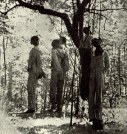|
|
 |
 |
|
Reading Guide |
| 5. |
Lynching
| - | Paul Laurence Dunbar, "The Haunted Oak," poem, 1895 |
| - | "The Dogwood Tree," postcard, 1908 |
| - | Ida B. Wells-Barnett, "Lynch Law in America," The Arena, January 1900 |
| - | "Ohio's Anti-Lynching Law," Cleveland Gazette, 8 June 1901 |
|
|
 |
Nothing is more disturbing from this period than lynching. Not only the act itself, but the impunity with which it was used as an instrument of terror and subjugation throughout the South. Thousands of black people were tortured, branded, mutilated, dismembered, and finally hanged or burned by mobs who knew their mode of "justice" would go unpunished. Hundreds of postcards were produced depicting gleeful crowds exhibiting their victims. Lynching "has become so common," wrote a Methodist bishop in 1893, "that it no longer surprises." Anti-lynching movements were spurred by black and white activists, especially women. Anti-lynching bills were submitted in state legislatures, most of which were not passed until the 1930s. Congress never passed an anti-lynching law due to the opposition of Southern Democrats. U.S. presidents of the time rarely made an anti-lynching gesture.
These four documents present a cross-section of the lynching issue, from a white-produced threat postcard to black-initiated efforts to end lynching. They are difficult reading, but that is a given for this topic. 13 pages.
Discussion questions
- How did whites justify lynching? Why did they get away with it?
- How do Wells and Dunbar appeal to the American conscience? How do they refute the justifications of lynching?
- What methods of recourse are recommended by Wells? by the Cleveland Gazette? Will they work?
- How does intimidation through terror function today?
|
» Link |
 |
 |
Topic Framing Questions
| • |
What forms of political action did African Americans initiate? For what goals? |
| • |
How was political action affected by the increase in discrimination and violence during the 1890s? |
| • |
How did black leaders frame their political objectives for their white audience? |
| • |
To what extent did black political action affect the lives of ordinary African Americans? |
|
|
 |
 |
|
 |
